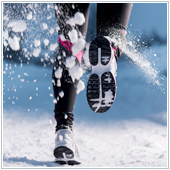 Maintaining an exercise routine year-round can be tough. When it’s cold outside, it can be even more difficult, especially if you enjoy outdoor exercise. Even the most disciplined fitness addicts tend to get discouraged when the temperatures drop below freezing. If you remain dedicated to your fitness routine in the face of cold temperatures, we applaud you. Just make sure you read our recommendations for staying healthy and safe when exercising outside this winter.
Maintaining an exercise routine year-round can be tough. When it’s cold outside, it can be even more difficult, especially if you enjoy outdoor exercise. Even the most disciplined fitness addicts tend to get discouraged when the temperatures drop below freezing. If you remain dedicated to your fitness routine in the face of cold temperatures, we applaud you. Just make sure you read our recommendations for staying healthy and safe when exercising outside this winter.
#1: Be cognizant of your own limitations.
While outdoor exercise can be exhilarating, it can also present a danger for some people. If you have certain conditions, including asthma or heart problems, check with a healthcare professional before pushing your limits in colder temperatures.
#2: Choose your clothing and footwear carefully.
First and foremost, you need to consider warmth. When you’re working up a sweat, you may feel much warmer than it actually is. But when you start to cool down, the sweat on your body will give you a chill. The best solution is to dress in layers and swap cotton clothing for sweat-wicking materials that will keep the wet materials off of your skin.
When roads are covered in ice and snow, your footwear is of critical importance. Be sure to wear a trail shoe with a wide tread to decrease your chances of slipping. You may also want to consider purchasing shoes a half size larger to accommodate thick socks for added warmth.
Because blood flow is concentrated in the body’s core during cold weather, your extremities are extra susceptible to frostbite. You’ll want to wear gloves lined with fleece or wool, a pair of extra socks and a hat or headband to cover your ears. You may also consider chemical heat packs to warm your feet and hands.
#3: Don’t make it harder than you have to.
Experts and healthcare professionals alike recommend running into the wind first. That way, you’ll head home with the wind at your back. You’ll be less likely to get cold as you’ll probably be moving slower toward the end of your workout and you’ll be wet with sweat.
Don’t forget that running in the snow and ice is more difficult than an easy, breezy, summertime jog. When you’re facing harsh winter conditions, you should place importance on time, not distance. Moving around ice patches will require more time and energy and warming up your muscles will take longer, so moving at a slower pace will be unavoidable.
#4: Be smart and responsible.
Wear sunscreen, stay hydrated and check the weather forecast. Exercising outside in the cold and rain presents additional risks as your inability to stay dry will lower your body temperature even more. Extreme wind chill can penetrate your clothing and increase your vulnerability to frostbite. Additionally, temperatures below zero can present unnecessary risks.
Don’t forget about your indoor options. While many serious runners believe that running on a treadmill isn’t as strenuous, it’s still a great option when outdoor conditions are less than desirable. Alternatively, you may consider giving your body a complete break for up to five days and rest assured that you haven’t lost any fitness.
If you have questions about how a condition or medication may play a role in outdoor exercise, please don’t hesitate to give us a call at [phone_main]. As always, we are here to help.